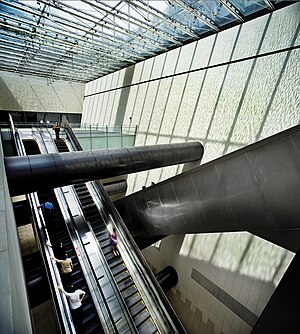
The Mass Rapid Transit system, locally known by the initialism MRT, is a rapid transit system in Singapore and the island country's principal mode of railway transportation. The system commenced operations in November 1987 after two decades of planning with an initial 6 km (3.7 mi) stretch consisting of five stations. The network has since grown to span the length and breadth of the country's main island – with the exception of the forested core and the rural northwestern region – in accordance with Singapore's aim of developing a comprehensive rail network as the backbone of the country's public transportation system, averaging a daily ridership of 3.45 million in 2023.

The Circle Line (CCL) is a medium-capacity Mass Rapid Transit (MRT) line in Singapore. It runs in a loop from Dhoby Ghaut station in the city-centre to HarbourFront station in the south via Bishan station in the centre of the country. It also has a branch to Marina Bay station from Promenade station, which will be extended to HarbourFront station from 2026 to form a complete loop. Coloured orange on the rail map, the fully-underground line is approximately 35.5 kilometres (22.1 mi) long with 30 stations. Travelling from one end of the line to the other takes about an hour.

Dhoby Ghaut MRT station is an underground Mass Rapid Transit (MRT) interchange station on the North South, North East and Circle lines in Singapore. Located beneath the eastern end of Orchard Road shopping belt in Dhoby Ghaut, Museum Planning Area, the station is integrated with the commercial development The Atrium@Orchard. The station is near landmarks such as The Istana, the MacDonald House, Plaza Singapura and Dhoby Ghaut Green.
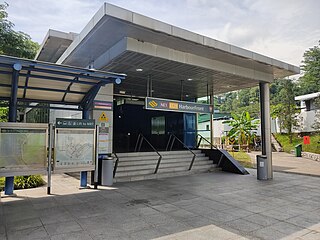
HarbourFront MRT station is an underground Mass Rapid Transit (MRT) interchange station in Singapore. The termini of the North East line (NEL) and Circle line (CCL), the station serves the HarbourFront area and Sentosa. Surrounding retail and commercial developments include VivoCity and HarbourFront Centre, and the station is near HarbourFront Bus Interchange and the Singapore Cruise Centre.

Paya Lebar MRT station is a Mass Rapid Transit (MRT) interchange station on the East West line (EWL) and Circle line (CCL) in Geylang, Singapore. Despite the name, this station is not located in Paya Lebar but rather along Paya Lebar Road, near the junction with Sims Avenue. It is located among the developments of the Paya Lebar Central commercial hub and near the Geylang Serai district.

Marina Bay MRT station is an underground Mass Rapid Transit (MRT) interchange station on the North South (NSL), Circle (CCL) and Thomson–East Coast (TEL) lines in Singapore. Located in the Downtown Core district near Marina Bay, the station serves the Marina One Residences, Marina Bay Suites and the Marina Bay Financial Centre.
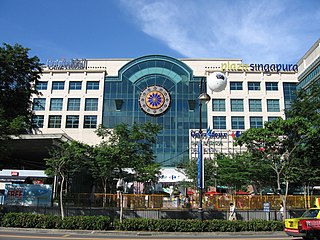
Dhoby Ghaut is a place in Singapore that often refers to the MRT station of the same name, which is a major interchange station on Singapore's Mass Rapid Transit network connecting the North-South Line, North East Line, and the Circle Line. As a place, Dhoby Ghaut lies along the eastern end of Orchard Road. There is a shopping mall above the MRT station called Plaza Singapura.
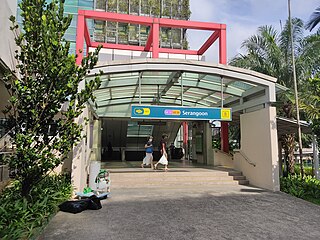
Serangoon MRT station is an underground Mass Rapid Transit (MRT) interchange station on the North East (NEL) and Circle (CCL) lines. Situated in Serangoon, Singapore along Upper Serangoon Road and Serangoon Central, the station is integrated with the Nex shopping complex and the Serangoon Bus Interchange. The station is near the Serangoon Neighbourhood Police Centre and Braddell Heights Community Hub and serves various residential estates in the area.
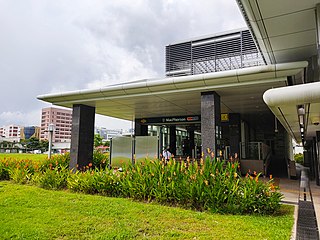
MacPherson MRT station is an underground Mass Rapid Transit (MRT) interchange station on the Downtown line and Circle line in Geylang planning area, Singapore, located underneath Paya Lebar Road at the junction with Circuit Link and Ubi Avenue 2.

Promenade MRT station is an underground Mass Rapid Transit (MRT) interchange station on the Downtown (DTL) and Circle (CCL) lines in Downtown Core, Singapore. Located underneath Temasek Avenue and adjacent to Millenia Tower, the station serves several key attractions and locations such as Suntec City and the Marina Promenade, which the station is named after. The station is at the junction of the Dhoby Ghaut and Marina Bay branches of the CCL.
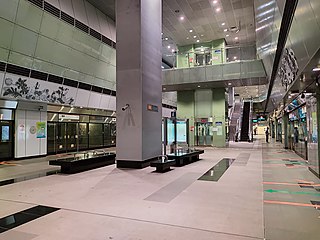
Nicoll Highway MRT station is an underground Mass Rapid Transit (MRT) station on the Circle Line (CCL) in Singapore. Located in the Downtown Core underneath Republic Avenue near the Kallang River, the station serves commercial and residential developments along Nicoll Highway, such as the Golden Mile Complex and The Concourse. The station is operated by SMRT Trains.
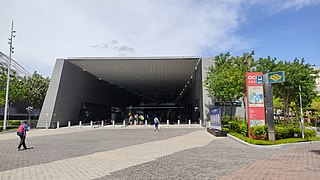
Stadium MRT station is an underground Mass Rapid Transit (MRT) station on the Circle Line (CCL). Located in the area of Kallang, Central Region, Singapore, the station serves the Singapore Sports Hub and its facilities including the National Stadium, Indoor Stadium, Kallang Theatre and Leisure Park Kallang. It is operated by SMRT Trains.
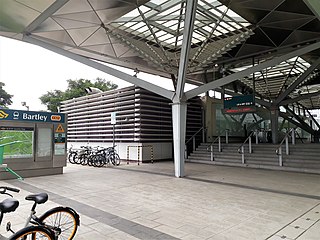
Bartley MRT station is an underground Mass Rapid Transit (MRT) station on the Stage 3 of the Circle line, located on the boundary of Serangoon and Toa Payoh planning areas, Singapore.

Esplanade MRT station is an underground Mass Rapid Transit (MRT) station on the Circle Line (CCL) in Singapore. Situated in the Downtown Core, it is at the junction of Bras Basah Road, Raffles Boulevard and Nicoll Highway. As the name suggests, the station serves the Esplanade performing arts centre, alongside various developments such as War Memorial Park, Suntec City Mall and the Suntec Singapore Convention and Exhibition Centre. Esplanade station is linked to the nearby City Hall station via CityLink Mall, an underground retail development.

Bayfront MRT station is an underground Mass Rapid Transit (MRT) interchange station on the Downtown line (DTL) and Circle line (CCL). Located in the Downtown Core of Singapore, the station is underneath Bayfront Avenue and serves the main tourist attractions of Marina Bay Sands and Gardens by the Bay.

Haw Par Villa MRT station is an underground Mass Rapid Transit (MRT) station on the Circle line (CCL) in Queenstown, Singapore. Located underneath West Coast Highway and Pasir Panjang Road, the station serves the nearby Haw Par Villa, alongside the Pasir Panjang Wholesale Centre.
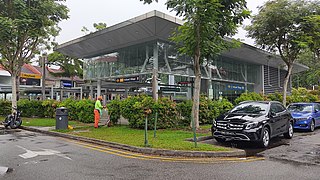
Holland Village MRT station is an underground Mass Rapid Transit (MRT) station on the Circle line (CCL), located along the boundary of Bukit Timah and Queenstown planning areas in Singapore. Situated close to the junction of Holland Avenue and Holland Road, it primarily serves the area of Holland Village, where its name was derived from. The station is operated by SMRT Trains.

The Museum Planning Area is a planning area located in the Central Area of the Central Region of Singapore. The area plays a "bridging role" between the Orchard area and the Downtown Core, which necessitates proper transport networks for vehicles, pedestrians and public transport. Due to the sheer size of green areas in the district, the Urban Redevelopment Authority (URA) has designated it a 'green lung' in the Central Area. However, the Museum Planning Area is also home to cultural and commercial activities. Around 65% of the area is available for future development, making it a hotbed for new infrastructure and buildings.
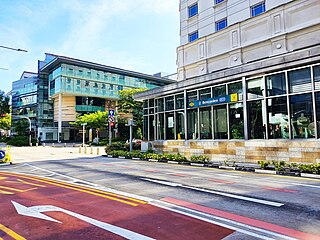
Bencoolen MRT station is an underground Mass Rapid Transit (MRT) station on the Downtown Line (DTL) in Singapore. Located under Bencoolen Street, the station serves primarily the Nanyang Academy of Fine Arts (NAFA), Singapore Management University and surrounding developments. At 43 metres (141 ft) below street level, Bencoolen is the deepest station in Singapore.
